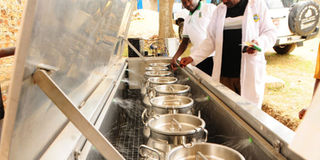Uganda’s dairy industry suffers from Kenyan ban

The escalating trade dispute between Kenya and Uganda over milk exports, is just one of many facing all EAC partner states. PHOTO/FILE
That Kenya is a lifeline for the dairy industry in Uganda is not in doubt.
Therefore, when Kenya slapped the Mbarara based Lato Milk with an import ban early in the year, the effects were devastating for farmers in the neighbouring state.
After several complaints by Kenyan farmers over the influx of Ugandan milk, which had seen a litre touch the historic low of Sh17, the government reacted by confiscating thousands of tonnes of milk from Uganda and consequently stopping imports.
The move did not only cause an uproar in Uganda, but also saw hundreds of workers in Pearl Dairies, the makers of Lato Milk sent on leave with production at the firm cut to bare minimum.
Uganda produces 2.6 billion litres of milk per annum. However, domestic demand stands at only 800 million litres, creating a huge surplus.
It is this surplus that finds its way to the Kenyan market, stepping up competition for local producers.
The attractiveness of Ugandan milk is helped by a lower production cost that stands at about Sh17 when compared with Kenya’s Sh26 on average per litre.
By the time Kenya banned Lato Milk from the market, it was retailing at about Sh40 for a half litre while the local brands traded at Sh45 on average, leaving processors with unmoving stocks as price sensitive consumers preferred the cheaper imported product.
The bone of contention has been whether Uganda has the capacity to produce all this surplus, with allegations that much of it comes from third party countries as powder milk then reconstituted in the neighbouring country before finding its way to Kenya.
Mr Stanley Ng’ombe, the chairperson of the Kenya Dairy Farmers Federation (KDFF), said imported milk has had a negative impact on farmers, driving down the volumes that they can afford to produce because of the low prices.
Mr Ng’ombe, whose organisation counts a membership of 26 dairy cooperatives scattered across the country, claims that most of the milk coming from Uganda is imported into that country as powder from Europe.
“We know that Uganda has no capacity to produce all this milk and there is a likelihood that most of it come from Europe before finding its way to Kenya,” he said.
Business Daily




